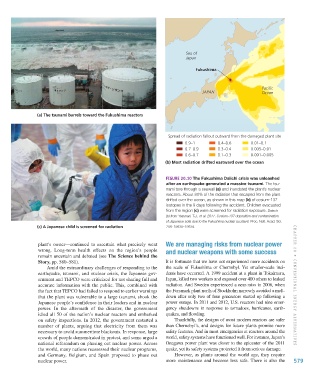Page 580 - Environment: The Science Behind the Stories
P. 580
Sea of
Japan
Fukushima
Pacific
JAPAN Ocean
(a) The tsunami barrels toward the Fukushima reactors
Spread of radiation fallout outward from the damaged plant site
0.9–1 0.4–0.6 0.01–0.1
0.7–0.9 0.3–0.4 0.005–0.01
0.6–0.7 0.1–0.3 0.001–0.005
(b) Most radiation drifted eastward over the ocean
FIGURE 20.10 The Fukushima Daiichi crisis was unleashed
after an earthquake generated a massive tsunami. The tsu-
nami tore through a seawall (a) and inundated the plant’s nuclear
reactors. About 80% of the radiation that escaped from the plant
drifted over the ocean, as shown in this map (b) of cesium-137
isotopes in the 9 days following the accident. Children evacuated
from the region (c) were screened for radiation exposure. Data in
(b) from Yasunari, T.J., et al. 2011. Cesium-137 deposition and contamination
of Japanese soils due to the Fukushima nuclear accident. Proc. Natl. Acad. Sci.
(c) A Japanese child is screened for radiation 108: 19530–19534.
plant’s owner—continued to ascertain what precisely went We are managing risks from nuclear power
wrong. Long-term health effects on the region’s people and nuclear weapons with some success
remain uncertain and debated (see The Science behind the
Story, pp. 580–581). It is fortunate that we have not experienced more accidents on
Amid the extraordinary challenges of responding to the the scale of Fukushima or Chernobyl. Yet smaller-scale inci-
earthquake, tsunami, and nuclear crisis, the Japanese gov- dents have occurred. A 1999 accident at a plant in Tokaimura,
ernment and TEPCO were criticized for not sharing full and Japan, killed two workers and exposed over 400 others to leaked
accurate information with the public. This, combined with radiation. And Sweden experienced a near-miss in 2006, when CHAPTER 20 • CONVENTI ON AL ENERGY ALTERN ATIVES
the fact that TEPCO had failed to respond to earlier warnings the Forsmark plant north of Stockholm narrowly avoided a melt-
that the plant was vulnerable to a large tsunami, shook the down after only two of four generators started up following a
Japanese people’s confidence in their leaders and in nuclear power outage. In 2011 and 2012, U.S. reactors had nine emer-
power. In the aftermath of the disaster, the government gency shutdowns in response to tornadoes, hurricanes, earth-
idled all 50 of the nation’s nuclear reactors and embarked quakes, and flooding.
on safety inspections. In 2012, the government restarted a Thankfully, the designs of most modern reactors are safer
number of plants, arguing that electricity from them was than Chernobyl’s, and designs for future plants promise more
necessary to avoid summertime blackouts. In response, large safety features. And in most emergencies at reactors around the
crowds of people demonstrated in protest, and some urged a world, safety systems have functioned well. For instance, Japan’s
national referendum on phasing out nuclear power. Across Onagawa power plant was closer to the epicenter of the 2011
the world, many nations reassessed their nuclear programs, quake, yet its safety systems protected it from serious damage.
and Germany, Belgium, and Spain proposed to phase out However, as plants around the world age, they require
nuclear power. more maintenance and become less safe. There is also the 579
M20_WITH7428_05_SE_C20.indd 579 13/12/14 1:56 PM

